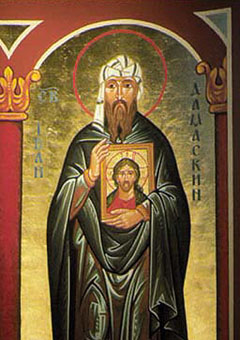| John of Damascus  Born: c. 676 AD Born: c. 676 AD
Birthplace: Damascus, Syria
Died: 4-Dec-749 AD
Location of death: Jerusalem, Palestine
Cause of death: unspecified
Gender: Male
Religion: Christian
Race or Ethnicity: White
Occupation: Religion Executive summary: Early scholastic church father John of Damascus, or Johannes Damascenus, an eminent theologian of the Eastern Church, derives his surname from Damascus, where he was born about the close of the 7th century. His Arabic name was Mansur (the victor), and he received the epithet Chrysorrhoas (gold-pouring) on account of his eloquence. The principal account of his life is contained in a narrative of the 10th century, much of which is obviously legendary. His father Sergius was a Christian, but notwithstanding held a high office under the Saracen caliph, in which he was succeeded by his son. John is said to have owed his education in philosophy, mathematics and theology to an Italian monk named Cosmas, whom Sergius had redeemed from a band of captive slaves. About the year 730 he wrote several treatises in defense of image-worship, which the emperor, Leo the Isaurian, was making strenuous efforts to suppress.
Various pieces of evidence go to show that it was shortly after this date that he resolved to forsake the world, divided his fortune among his friends and the poor, and betook himself to the monastery of St. Sabas, near Jerusalem, where he spent the rest of his life. After the customary probation he was ordained priest by the patriarch of Jerusalem. In his last years he travelled through Syria contending against the iconoclasts, and in the same cause he visited Constantinople at the imminent risk of his life during the reign of Constantine Copronymus. With him the "mysteries", the entire ritual, are an integral part of the Orthodox system, and all dogma culminates in image-worship. The date of his death is uncertain; it is probably about 752. John Damascenus is a saint both in the Greek and in the Latin Churches, his festival being observed in the former on the 29th of November and on the 4th of December, and in the latter on the 6th of May.
The works of Damascenus give him a foremost place among the theologians of the early Eastern Church, and, according to Dorner, he "remains in later times the highest authority in the theological literature of the Greeks." This is not because he is an original thinker but because he compiled into systematic form the scattered teaching of his theological predecessors. Several treatises attributed to him are probably spurious, but his undoubted works are numerous and embrace a wide range. The most important contains three parts under the general title "The Fountain of Knowledge." The first part is an exposition and application of theology of Aristotle's Dialectic. The second, "Of Heresies", is a reproduction of the earlier work of Epiphanius, with a continuation giving an account of the heresies that arose after the time of that writer. The third part, "An Accurate Exposition of the Orthodox Faith", is much the most important, containing as it does a complete system of theology founded on the teaching of the fathers and church councils, from the 4th to the 7th century. It thus embodies the finished result of the theological thought of the early Greek Church. Through a Latin translation made by Burgundio of Pisa in the 12th century, it was well known to Peter Lombard and St. Thomas Aquinas, and in this way it influenced the scholastic theology of the West. Another well-known work is the Sacra parallela, a collection of biblical passages followed by illustrations drawn from other scriptural sources and from the fathers. There is much merit in his hymns and "canons" one of the latter is very familiar as the hymn "The Day of Resurrection, Earth tell it out abroad." John of Damascus has sometimes been called the "Father of Scholasticism", and the "Lombard of the Greeks", but these epithets are appropriate only in a limited sense.
The Christological position of John may be summed up in the following description: "He tries to secure the unity of the two natures by relegating to the divine Logos the formative and controlling agency. It is not a human individual that the Logos assumes, nor is it humanity, or human nature in general. It is rather a potential human individual, a nature not yet developed into a person or hypostasis. The hypostasis through which this takes place is the personal Logos through whose union with this potential man, in the womb of Mary, the potential man acquires a concrete reality, an individual existence. He has, therefore, no hypostasis of himself but only in and through the Logos. It is denied that he is non-hypostatic; it is affirmed that he is en-hypostatic. Two natures may form a unity, as the body and soul in man. So man, both soul and body, is brought into unity with the Logos; there being then one hypostasis for both natures." There is an interchange of the divine and human attributes, a communication of the former which deifies the receptive and passive human nature. In Christ the human will has become the organ of the divine will. Thus while John is an adherent of Chalcedon and a dyothelite, the drift of his teaching is in the monophysite direction. "The Chalcedonian Definition is victorious, but Apollinaris is not overcome"; what John gives with the one hand he takes away with the other. On the question of the Atonement he regards the death of Christ as a sacrifice offered to God and not a ransom paid to the devil.
Father: Sergius
Canonization
Do you know something we don't?
Submit a correction or make a comment about this profile
Copyright ©2019 Soylent Communications
|